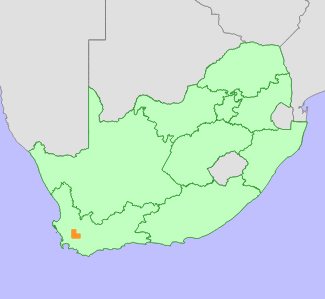|
Scientific Name | Aspalathus amoena (R.Dahlgren) R.Dahlgren |
Higher Classification | Dicotyledons |
Family | FABACEAE |
Synonyms | Aspalathus retroflexa L. subsp. amoena R.Dahlgren |
National Status |
Status and Criteria | Critically Endangered C2a(i); D |
Assessment Date | 2015/04/24 |
Assessor(s) | A.L. Schutte-Vlok, D. Raimondo & D. van der Colff |
Justification | EOO and AOO of less than 6 km². This species is known from three very small sub-populations each with less than 10 individuals. It is occurs in an endangered vegetation type (Breede Alluvium Fynbos), of which 86% has been lost to agricultural expansion. It is threatened by ongoing habitat loss and degradation as well as competition from unmanaged invasive alien plants. |
Distribution |
Endemism | South African endemic |
Provincial distribution | Western Cape |
Range | Breede River Valley north of Rawsonville. |
Habitat and Ecology |
Major system | Terrestrial |
Major habitats | Breede Sand Fynbos, Breede Alluvium Fynbos |
Description | Breede Alluvium Fynbos, in sand that accumulates on riverbanks. |
Threats |
| Species is restricted to the sandy flats of the Breede River Valley, where 86% of its habitat has been lost to crop cultivation (citrus and vines). The remaining fragments of this vegetation type are densely infested with unmanaged invasive alien plants (Acacia mearnsii). |
Population |
This species was previously thought to be extinct, but three small subpopulations numbering less than 10 mature individuals were recently rediscovered. It is multistemmed, and suspected to be a resprouter, but its response to fire needs to be studied. If it is a resprouter, the population size is unlikely to fluctuate in response to fire, as is the case in many other Aspalathus species.
|
Population trend | Decreasing |
Assessment History |
Taxon assessed |
Status and Criteria |
Citation/Red List version | | Aspalathus amoena (R.Dahlgren) R.Dahlgren | CR C2a(i); D | 2015.1 | | Aspalathus amoena (R.Dahlgren) R.Dahlgren | Critically Endangered (Possibly Extinct) | Raimondo et al. (2009) | |
Bibliography |
Dahlgren, R. 1968. Revision of the genus Aspalathus. II. The species with ericoid and pinoid leaflets. 6. The Aspalathus frankenioides, nivea, juniperina, rubens, and divaricata groups and some other groups. Opera Botanica 21:8-304.
Dahlgren, R. 1988. Crotalarieae (Aspalathus). In: O.A. Leistner (ed). Flora of southern Africa 16 Fabaceae, Part 3 Papilionoideae, Fascicle 6:1-430. National Botanical Institute, Pretoria.
Goldblatt, P. and Manning, J.C. 2000. Cape Plants: A conspectus of the Cape Flora of South Africa. Strelitzia 9. National Botanical Institute, Cape Town.
Raimondo, D., von Staden, L., Foden, W., Victor, J.E., Helme, N.A., Turner, R.C., Kamundi, D.A. and Manyama, P.A. 2009. Red List of South African Plants. Strelitzia 25. South African National Biodiversity Institute, Pretoria.
|
Citation |
| Schutte-Vlok, A.L., Raimondo, D. & van der Colff, D. 2015. Aspalathus amoena (R.Dahlgren) R.Dahlgren. National Assessment: Red List of South African Plants version 2024.1. Accessed on 2025/12/12 |
 Comment on this assessment
Comment on this assessment


